Port of Alaska Modernization Program
Safeguarding a critical transportation hub providing critical resources to Alaskans for future generations
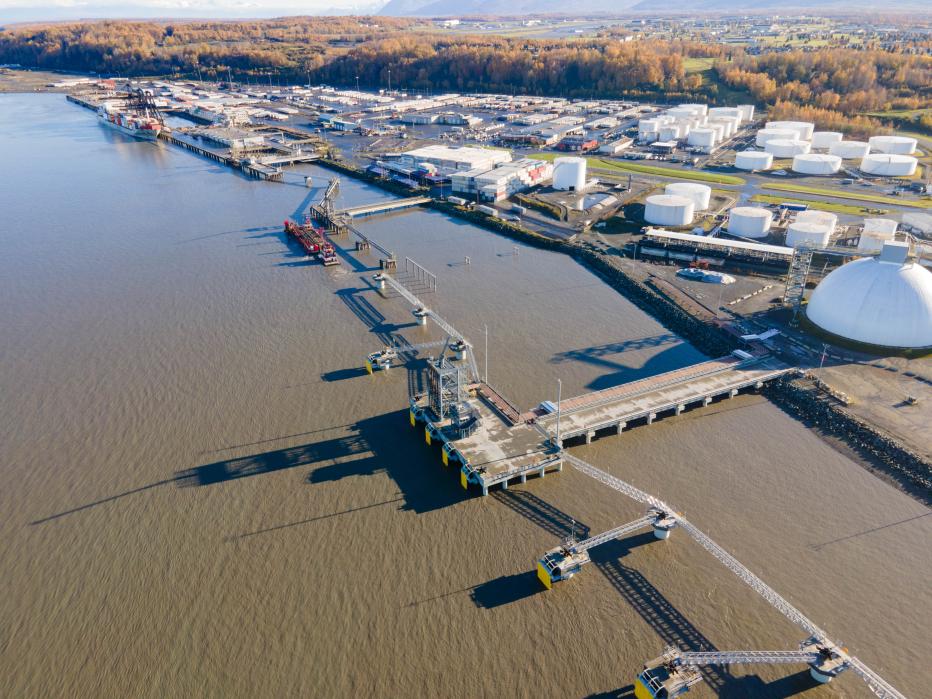
Aerial view of the Port of Alaska, Anchorage, AK, U.S. © Alex Herlant
The Don Young Port of Alaska (Port of Alaska), a critical transportation hub providing life-sustaining resources to the State of Alaska, is undergoing critical modernization projects to ensure vitality and livability of the communities that rely on it. Located in Anchorage, the port provides access to supplies including food, consumer goods, building materials and cars for Interior Alaskan communities, military facilities, mining operations and rural Native Alaskan villages. In addition to its local significance, the port plays a vital role nationally as it is identified as a strategic commercial seaport (part of the National Port Readiness Network, ensuring commercial ports are ready to support national defense emergencies).
The Port of Alaska is at a critical juncture where aging infrastructure will soon hinder operations. The original five terminals making up the port were constructed between the late 1950s and 1970s and the foundations have begun to deteriorate. It’s estimated that the deterioration of these terminals may begin posing restrictions to port operations by 2025 – or sooner if a large earthquake hits. Adding to the construction challenge is the unique climate and environment – cold, long winters, high tides, seismic activity and the marine and sea life that call the waterway home.
The Port of Alaska Modernization Program (PAMP) was created in 2014 to replace the aging infrastructure so that the Port may continue serving as Alaska’s key inbound cargo gateway, operating critical non-defense infrastructure, and supporting the movement of goods, industrial development and disaster recovery. Jacobs is serving as program manager providing program management and planning for this phased modernization program to provide four new terminals and any needed demolition.
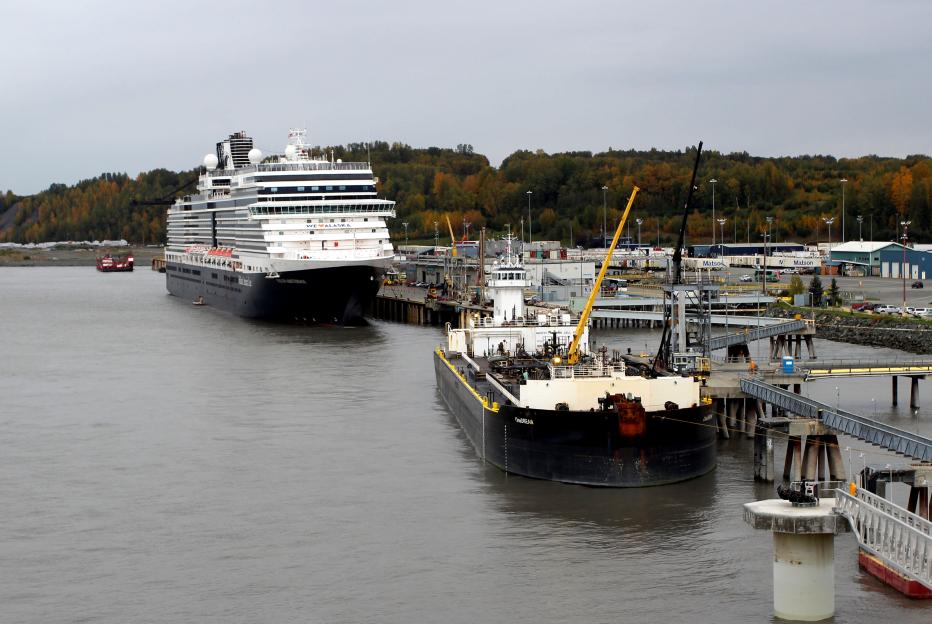
Cargo and commercial activities at the Port. © Alex Herlant
“The Don Young Port of Alaska is a critical transportation hub providing essential goods and services for the vitality of the communities that rely on it. Jacobs is proud to provide our program management services for this incredibly important program, helping the Port of Alaska in their efforts to safeguard the port for future generations.”
-
Don Young Port of Alaska
-
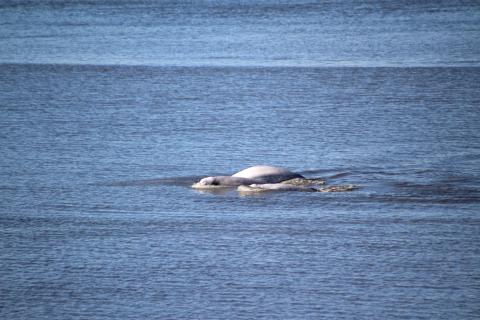
The endangered Cook Inlet Baluga whale at the Port. © Alex Herlant
-
Ice floes at the Port limit the construction season to 6 months. © Alex Herlant
A unique environment
With a location adjacent to Alaska’s population center, the port is ideally positioned to support the movement of goods and services. However, this location’s unique environment and climate also pose challenges to construction. The port is one of a few ports in the world operating in such an extreme and challenging environment.
- A cold climate - The in-water construction season is limited to just six months per year due to ice floes, practically doubling the number of construction seasons compared to a similar project in a warmer environment.
- Highest tides in the United States - The tides in Cook Inlet have a range of nearly 40 feet, creating swift currents necessitating a robust anchoring system for work vessels.
- Home to marine animals and fish - Many marine mammals and fish call the waterway home, including the endangered Cook Inlet beluga whale. Special operations are required, and design flexibility and construction methods have restrictions.
- More earthquakes than anywhere else in North America - As one of the most seismically active regions in the world, Alaska has more earthquakes than anywhere else in North America.
The details
The program consists of building four new terminals (Petroleum and Cement Terminal, Petroleum Terminal and Cargo Terminals 1 & 2), a new onshore administration building, The North Extension Stabilization Steps 1 & 2 and demolition of the existing terminals.
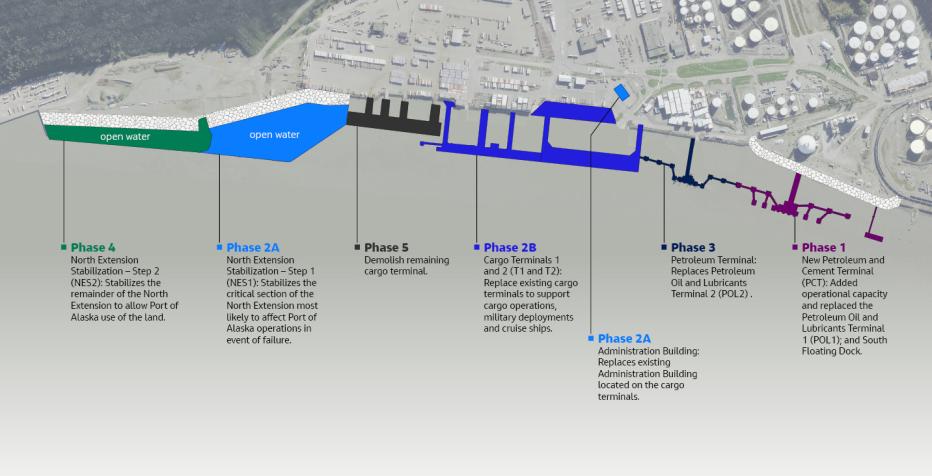
Completed in 2022, the new Petroleum and Cement Terminal (PCT) was the first of four terminals constructed as part of the program and allows the port to meet fuel and cement needs of Alaska. A significant percentage of the cement used in construction in Alaska goes through this terminal. The PCT is a pile-supported dock and is Alaska’s only dock equipped with a bulk cement unloading and transfer system. The PCT serves as one of the Port of Alaska's two petroleum terminals and will replace the corroded Petroleum, Oils and Lubricants Terminal 1 (POL1), which was built in 1965 and suffered significant structural damage during a magnitude 7.1 earthquake in November 2018.
Three cargo terminals currently operate year-round and provide 90% of Alaskans with critical goods making continuity of operations key. Two new cargo terminals will be built replacing the existing three terminals which will be partially demolished in a phased approach. The new terminals are designed longer to accommodate newer, larger vessels requiring two instead of the three existing terminals. The new terminals will have seismically capable structures built 140 feet seaward of the existing structure to reduce sedimentation impact, improve berthing safety and allow for continued port operations during construction. Preliminary design of Cargo Terminal 1 was completed in 2022. To maintain operations, Cargo Terminal 1 will be the first terminal constructed, located south of the existing terminals which will remain in use during construction. Final design for Cargo Terminal 2 is anticipated to begin 2025 with construction beginning after Cargo Terminal 1 construction is complete.
A new Petroleum Terminal will replace the existing Petroleum Terminal (POL2) and is in the planning stages. This new terminal is planned for construction after the cargo terminals are finished.
The old Administration Building was on an original cargo terminal platform which is deteriorating and will be demolished. Construction of the new Administration Building began in 2022 and was completed in 2024. The new Administration Building is located onshore, which allowed for operations to continue during construction.
The North Extension is undergoing a two-step stabilization effort (NES1 and NES2) to allow for safer and more navigable berthing for vessels. The North Extension was built in 2009 to serve as an intermodal expansion but by 2012 was deemed to be failing. Step 1 (NES1) will stabilize a critical section adjacent to the shipping lane and construction is currently underway. Step 2 (NES2) is in the planning stages.
Did you know?
-
4
new terminals built as part of PAMP
-
75 %
the percentage of inbound cargo handled for Alaska
-
$ 14 B
in statewide economic activity driven by the Port annually
-
90 %
approximate percentage of Alaskans receiving life-sustaining necessities passing through the cargo terminals
-
1
of a few ports in the world operating in such an extreme and challenging environment
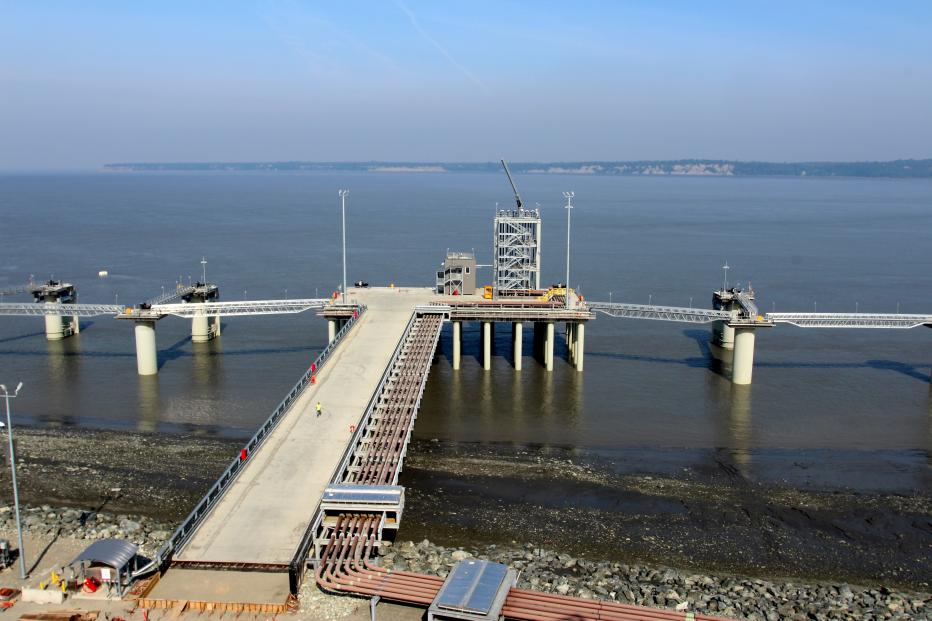
You might be interested in...
In the media
Port of Alaska Modernization Program: Program Website













































